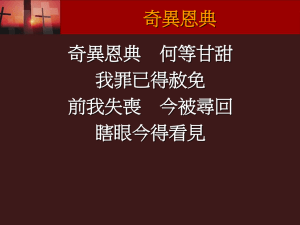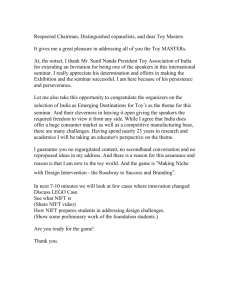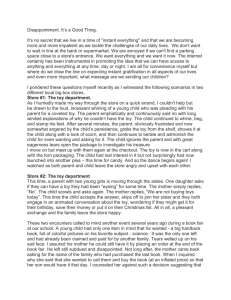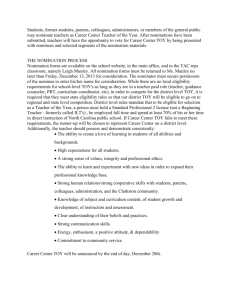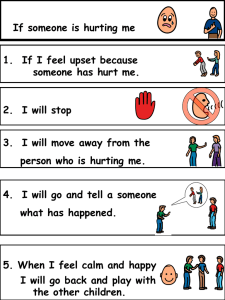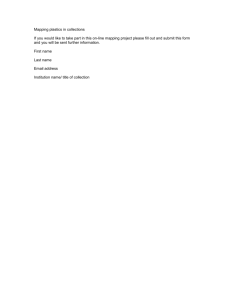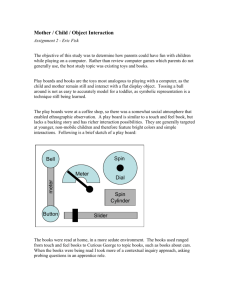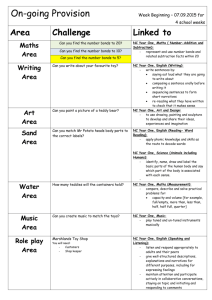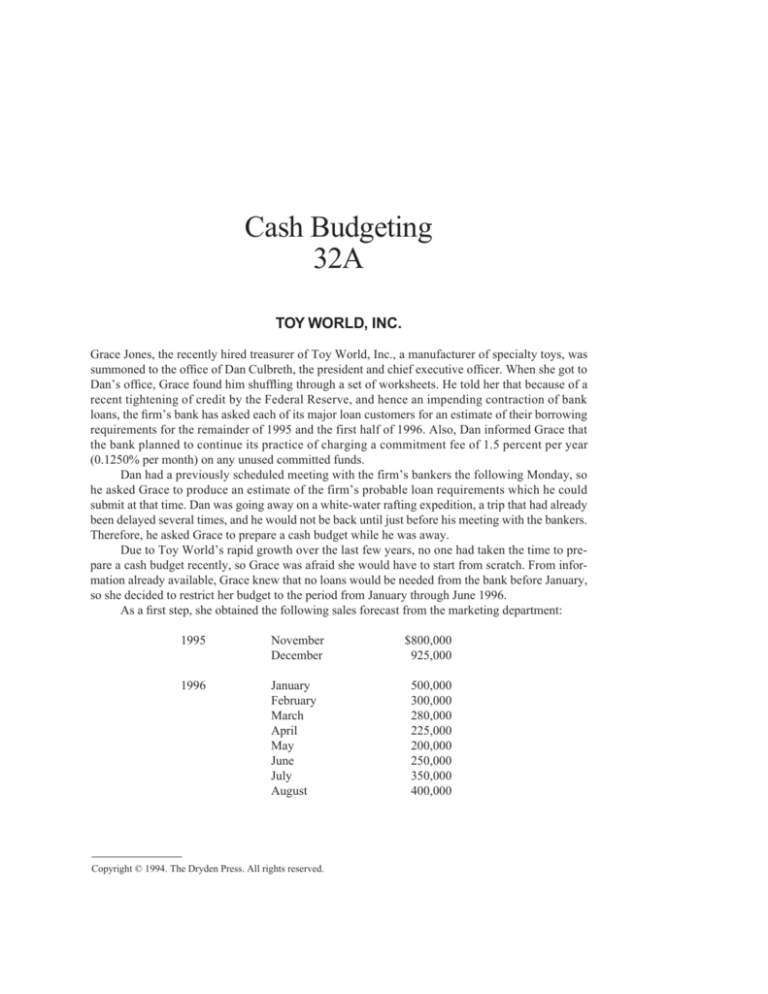
Cash Budgeting
32A
TOY WORLD, INC.
Grace Jones, the recently hired treasurer of Toy World, Inc., a manufacturer of specialty toys, was
summoned to the office of Dan Culbreth, the president and chief executive officer. When she got to
Dan’s office, Grace found him shuffling through a set of worksheets. He told her that because of a
recent tightening of credit by the Federal Reserve, and hence an impending contraction of bank
loans, the firm’s bank has asked each of its major loan customers for an estimate of their borrowing
requirements for the remainder of 1995 and the first half of 1996. Also, Dan informed Grace that
the bank planned to continue its practice of charging a commitment fee of 1.5 percent per year
(0.1250% per month) on any unused committed funds.
Dan had a previously scheduled meeting with the firm’s bankers the following Monday, so
he asked Grace to produce an estimate of the firm’s probable loan requirements which he could
submit at that time. Dan was going away on a white-water rafting expedition, a trip that had already
been delayed several times, and he would not be back until just before his meeting with the bankers.
Therefore, he asked Grace to prepare a cash budget while he was away.
Due to Toy World’s rapid growth over the last few years, no one had taken the time to prepare a cash budget recently, so Grace was afraid she would have to start from scratch. From information already available, Grace knew that no loans would be needed from the bank before January,
so she decided to restrict her budget to the period from January through June 1996.
As a first step, she obtained the following sales forecast from the marketing department:
1995
November
December
1996
January
February
March
April
May
June
July
August
Copyright © 1994. The Dryden Press. All rights reserved.
$800,000
925,000
500,000
300,000
280,000
225,000
200,000
250,000
350,000
400,000
Case: 32A Capital Budgeting
Note that the sales figures are before any discounts; that is, they are not net of discounts. Also, the
marketing people cautioned Grace to recognize that actual sales could vary substantially from the
forecasted levels, because kids are fickle in their choice of toys.
Toy World’s credit policy is 2/15, net 30. Hence, a 2 percent discount is allowed if payment is
made within 15 days of the sale; otherwise, payment in full is due 30 days after the date of sale. On
the basis of a previous study, Grace estimates that, generally, 35 percent of the firm’s customers
take the discount, 60 percent pay within 30 days, and 5 percent pay late, with the late payments
received about 60 days after the invoice date, on average. For monthly budgeting purposes, discount sales are assumed to be collected in the month of the sale, net sales in the month after the sale,
and late sales two months after the sale. Of course, variances could occur from all of these figures.
Toy World begins production of goods two months before the anticipated sale date. Variable
production costs are made up entirely of purchased materials and labor, which total 70 percent of
forecasted sales—30 percent for materials and 40 percent for labor. Again, these figures could
change if operating conditions departed from norms. All materials are purchased just before production begins, or two months before the sale of the finished goods. On average, Toy World pays
60 percent of the materials cost in the month when it receives the materials, and the remaining 40
percent the next month, or one month prior to the sale. Half of the labor expenses are paid two
months prior to the sale, while the remaining 50 percent is paid one month before the sale.
Toy World pays fixed general and administrative expenses of approximately $95,000 a month,
while lease obligations amount to $60,000 per month. Both expenditures are expected to continue
at the same level throughout the forecast period. The firm estimates miscellaneous expenses to be
$40,000 monthly, and fixed assets are currently being depreciated at the rate of $47,500 per month.
Toy World has $1,600,000 (book value) of bonds outstanding. They carry a 10 percent semi-annual
coupon, and interest is paid on January 15 and July 15. Also, the company is planning to replace an
old machine in June with a new one expected to cost $100,000. The old machine has both a zero
book and a zero market value. Federal and state income taxes are expected to be $90,000 quarterly,
and payments must be made on the 15th of December, March, June, and September. Toy World
has a target minimum cash balance of $450,000, and this amount will be on hand on January 1, 1996.
Assume that you were recently hired as Grace Jones’s assistant, and she has turned the job of
preparing the cash budget over to you. You must meet with her and Dan Culbreth on Sunday night
to review the budget prior to Dan’s meeting with the bankers on Monday. You recall the cash budgeting process from your recently completed finance course, and you plan to use the format shown
in Table 1 as a guide to prepare a monthly cash budget for Toy World for January through June 1996.
Based on information obtained from the firm’s credit department, Grace suggests that the following assumptions be used to prepare the budget. Initially, disregard both interest payments on shortterm bank loans and interest received from investing surplus funds. Also, assume that all cash
flows occur on the 15th of each month. Finally, note that collections from sales in November and
December of 1995 will not be completed until January and February of 1996, respectively.
Grace is extremely concerned about the peak funds shortfall during the 6-month planning
period. She is hoping that a $500,000 line of credit will be sufficient to cover any expected cash
shortfall. There has been talk in the industry about changes under which suppliers would bill on
terms requiring payments early in each month and, separately, customers would pay toward the
end of the month. If these changes are made, competition would force Toy World to adapt to them.
Therefore, Grace would also like to know how the cash budget would be affected if Toy World’s
cash outflows start to cluster at the beginning of the month, while collections become heaviest
toward the end of the month.
At the last minute, Grace decided that a daily cash budget for the month of January should also
be developed (Table 2 is provided as a guide).
She obtained the following information from Toy World managers for use in developing the daily
cash budget:
(1) Toy World normally operates 7 days a week.
Case: 32A Capital Budgeting
(2) Sales generally occur at a constant rate throughout the month; that is, 1/31 of the January
sales are made each day.
(3) Daily sales typically follow the 35 percent, 60 percent, 5 percent collection breakdown.
(4) Discount purchasers take full advantage of the 15-day discount period before paying, and
“on time” purchasers wait the full 30 days to pay. Thus, collections during the first 15 days
of January will reflect discount sales from the last 15 days of December, plus “regular” sales
made in earlier months. Also, on January 31, Toy World will begin collecting January’s net
sales and December’s late sales.
(5) The lease payment is made on the first of the month.
(6) Fifty percent of both labor costs and general and administrative expenses are paid on the 1st
and 50 percent are paid on the 15th.
(7) Materials are assumed to be delivered on the 1st and paid for on the 5th.
(8) Miscellaneous expenses are incurred and paid evenly throughout the month, 1/31 each day.
(9) Required interest payments are made on the 15th.
(10) The target cash balance is $450,000, and this amount must be in the bank on each day. This
balance is higher than the firm would otherwise keep, but it is required as a compensating
balance under terms of the firm’s bank loan agreement. However, the bank may be willing to
renegotiate this provision.
Dan has expressed some concern about the efficient utilization of his firm’s cash resources.
Specifically, he has questioned whether or not seasonal variations should be incorporated into the
firm’s target balance. In other words, during months when cash needs are greatest, the target balance
would be somewhat higher, while the target would be set at a lower level during slack months. He
asked you to consider this situation and to run some numbers to demonstrate the effect of using different target balances. Of course, this would require a modification to the bank loan agreement.
Grace noted that the only receipts shown in Toy World’s cash budget are collections. She
notes that Toy World pays a 7 percent interest rate on the short-term bank loan and would probably
earn 5 percent on surplus cash. She wants to know how these new items could be incorporated into
the cash budget. Additionally, she would like your views on an investment strategy for Toy World
to invest any surplus funds. Toy World’s policy has been to invest only in securities that provide liquidity and safety, yet offer a reasonable rate of return. Grace has heard about securities called
“derivatives” that are backed by U.S. Treasury bonds yet offer higher returns than T-bonds, and
she wonders if they should be used.
Dan Culbreth is an astute businessman, so he realizes that the cash budget is a forecast, and
that many of the cash flows shown are expected values rather than amounts known with certainty.
If actual sales, hence collections, are different from forecasted levels, the forecasted surpluses and
deficits would be incorrect. He is interested in knowing how various changes in the key assumptions
would affect the firm’s cash surplus or deficit. It would be particularly bad to obtain a $500,000
line of credit and then find that, because of incorrect assumptions, the actual loan requirement is
$700,000. Labor costs and many other expenses are set by contract at the start of the 6-month forecast period on the basis of the original expected sales. Therefore, many of the outflows cannot be
adjusted downward during the planning period even if sales decline below the forecasted levels.
Therefore, Dan sent Grace a memo requesting that the following three scenarios be specifically
considered:(1) What would be the impact on the monthly net cash flows from January to June 1996
if actual sales for November through June were 20 percent below the forecasted amounts? (2) What
if actual sales were only 50 percent of the forecasted level?(3) Even if sales are as expected, what
would happen if customers changed their payment patterns and began paying more slowly, such as
25 percent in the month of sale, 55 percent in the following month, and 20 percent in the second
month versus the old 35-60-5 pattern?
Case: 32A Capital Budgeting
Based on an analysis of the situation, recommend the size of the credit line Toy World should
seek. Think about any other related issues that Grace or Dan, or the bankers, might raise concerning the budgets. In particular, be prepared to explain the sources of all the numbers, and the effects
on the company’s cash requirements if any of the basic assumptions turn out to be incorrect. It would
be useful to do some sensitivity analyses, and to be prepared to answer various “what if” questions
Dan might ask. Be prepared to discuss the tradeoff between a high credit line with a high commitment fee versus a low credit line with a low commitment fee. Finally, Grace knows that Dan has
been thinking about altering the production process to produce at a level rate all during the year
rather than producing one month based on sales expected in the next month. How might such a
change affect loan requirements?
TABLE 1
Monthly Cash Budget Worksheet
November December
I. Collections and Payments
Gross Sales (expected)
Gross Sales (realized)
Collections:
Month of Sale
1 Month After Sale
2 Months After Sale
Total Collections
Purchases
Payments:
2 Months Before Sale
1 Month Before Sale
Total Payments
II. Cash Gain (Loss) For Month
Collections
Payments:
Purchases
Labor
2 Months Before Sale
1 Month Before Sale
General/Admin. Exp.
Lease
Miscellaneous Exp.
Taxes
Interest (on bonds)
New Equipment
January
February
March
April
$800,000
$800,000
$274,400
$317,275
$766,500
54,000
60,000
50,400
36,000
June
July
August
$200,000
$200,000
$250,000
$250,000
$350,000
$350,000
$400,000
$400,000
180,000
25,000
168,000
15,000
$ 68,600
135,000
14,000
$85,750
120,000
11,250
$ 60,000
$ 75,000
$105,000
$120,000
$449,150
$150,000
90,000
May
33,600
$ 86,400
$114,000
$766,500
$114,000
56,000
60,000
95,000
60,000
40,000
$ 56,000
$ 45,000
90,000
$ 40,000
$ 50,000
80,000
70,000
90,000
80,000
100,000
Total Payments
$477,400
Net Cash Gain (Loss)
$289,100
$79,050
TABLE 1 (continued)
Monthly Cash Budget Worksheet
January
February
III. Cash Surplus or Loan Requirement
Cash at Start (no borrowing)
November December
$450,000
$739,100
Cumulative Cash
$739,100
Target Cash Balance
$450,000
Surplus Cash or Total Loans Outstanding to Maintain
Target Cash Balance
$289,100
March
April
May
June
July
August
TABLE 2
Daily Cash Budget Worksheet
Day:
1
2
•••
5
•••
10
•••
15
16
•••
$16,129
•••
$16,129
•••
$ 16,129
$16,129
$29,471
•••
•••
•••
•••
28
29
30
31
•••
$16,129
$16,129
$ 29,471
$ 5,532
17,903
1,333
$24,768
•••
•••
•••
•••
$24,768
$ 5,532
17,903
1,492
$24,927
$ 5,532
9,677
1,492
$16,701
$
0
•••
$
$
$
$24,769
•••
I. Collections and Payments
Gross Sales
Collections:
Discount Payers
Net Payers
Late Payers
Total Collections
$ 16,129
•••
$ 10,235
17,903
1,333
$ 29,471
•••
•••
•••
•••
$29,471
•••
•••
•••
•••
Purchases
$ 84,000
Payments:
2 Months Before Sale
1 Month Before Sale
Total Payments
$
0
•••
$36,000
$86,400
•••
$
0
•••
$
Collections
$ 29,471 $29,471
Payments:
Purchases
Labor
2 Months Before Sale $ 28,000
1 Month Before Sale
30,000
General/Admin. Exp.
47,500
Lease
Miscellaneous Exp.
1,290
Taxes
Interest (on bonds)
Total Payments
$106,790
$1,290
Net Cash Gain (Loss)
($177,319)
•••
$29,471
•••
$29,471
•••
$ 29,471
0
$29,471
$
0
$24,768
$
0
0
0
0
II. Cash Gain (Loss) For Day
$24,769
$24,769
$24,927
$16,702
1,290
1,290
1,290
1,290
$ 1,290
$23,479
$ 1,290
$23,479
$ 1,290
$23,637
$ 1,290
$15,412
$86,400
$ 28,000
30,000
47,500
1,290
•••
$87,690
($58,219)
1,290
•••
$ 1,290
$28,181
1,290
•••
1,290
80,000
$186,790 $ 1,290
($157,319) $23,479
•••
TABLE 2 (continued)
Daily Cash Budget Worksheet
Day:
1
2
•••
5
•••
10
•••
15
16
•••
28
•••
$397,224
•••
$451,728
•••
$592,633
$435,314
•••
$717,056
29
30
31
$764,013
$787,650
III. Cash Surplus or Loan Requirement
Cash at Start
(no borrowing)
$450,000
$312,681
Cumulative Cash
$312,681
$340,862
$339,005
$479,909
$458,792
$787,650
$803,061
450,000
450,000
450,000
450,000
450,000
450,000
450,000
$337,650
$353,061
Target Cash Balance
Surplus Cash or
Total Loans Outstanding to
Maintain Target
Cash Balance
($137,319)
($109,138)
•••
($110,995)
•••
$ 29,909
•••
$
8,792
•••
$290,534
$314,013


